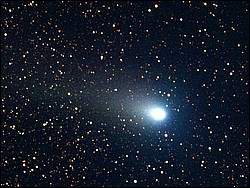 |
Throughout history, people have been both awed and alarmed by COMETS. Astronomers have long watched these periodic visitors including Englishman Edmond Halley, who first proved that comets are regular visitors of our solar system. Halley believed that several of the recorded bright comets might really be the same comet approaching the Sun at periodic intervals. He realized that one particularly bright comet was being sighted once every 76 years or so. It was recorded in 1531, also in 1607, and again in 1682. Halley predicted the comet’s next appearance to be in late 1758. When the comet appeared as predicted, Halley’s theory was proven correct and the comet was named in his honor. This was a rare occasion when a comet was named for the person who predicted its future appearance In most cases, comets are named for their discoverers. Comet Halley last approached the Sun in 1986 and will be back again in 2061.
Comets are dirty-ice leftovers from the formation of our solar-system around 4.5 billion years ago. They are among the least changed objects in our solar system, and, as such, may yield important clues about the formation of our solar system. Each comet has only a tiny solid part, called a nucleus, often no bigger than a few kilometers across. The nucleus contains icy chunks and frozen gases with bits of embedded rock and dust. At its center, the nucleus may have a small, rocky core.
Most comets arrive from a distant region called the Oort cloud about 100,000 astronomical units from the Sun (that is, 100,000 times the mean distance between the Earth and the Sun). As many as a trillion comets may reside in this cloud, orbiting the Sun near the edge of the Sun’s gravitational tug. Thus, any star passing nearby can change a comet’s orbit, flinging it into the inner solar system where we can see it. The large planets of our outer solar system are big enough that their gravity can also shift a comet into a different orbit.
In addition to the comets in the Oort Cloud, billions more orbit the Sun beyond the orbit of Pluto. This belt of comets is called the Kuiper Belt.
Around a dozen “new” comets are discovered each year. Most of them are long-period comets, meaning that they have orbits that can take as much as 30 million years to complete one trip around the Sun. (It takes Earth only 365 days to orbit the Sun.) Some are short-period comets, which can take less than 200 years to complete one orbit.
As a comet begins its inward pass toward the Sun, it begins to warm up and turns from a dark, cold object into one so bright that we can see it on Earth. This transformation occurs when the heat from the Sun vaporizes ice on the comet’s surface, causing the resultant gases to glow. “Vents” on the sun-warmed side may squirt fountains of dust and gas for several thousand kilometers. All this escaping material forms a large, tenuous atmosphere called a coma, typically a few hundred thousand kilometers in diameter. Solar energy and the flow of electrically charged particles, called the solar wind, blow the coma materials away from the Sun, forming the comet’s long, glowing tail, which is often split into a straight tail of electrically charged ions and an arching tail of dust. The tails of a comet always point away from the Sun.
Almost all comet orbits keep them safely away from the Sun itself. Comet Halley comes no closer than 89 million kilometers from the Sun, a distance well within our own Earth’s orbit. However, there are some comets, called sun-grazers, which may crash straight into the Sun or get so close they burn up.
NASA plans to launch several comet missions over the next few years. Deep Space 1 will be launched in July 1998, and arrive at Comet West-Kohoutek-Ikemura in June 2000. The mission will come within 500 kilometers of the comet and study the size and shape of the nucleus and the effect of the solar wind on the gases leaving the comet. Stardust will be launched in February 1999, and encounter Comet Wild in January 2004. Coming within 150 kilometers of the comet, it will also study the comet’s nucleus, the composition of comet dust, and bring a dust sample back to Earth in 2006. Contour will be launched July 2002, and will perform close flybys of comets Encke, Schwassman-Wachmann-3, and d’Arrest to study the diversity of comet nuclei. Deep Space 4 will be launched in April 2003, and land on the surface of Comet Tempel 1 in December 2005. It will study the nucleus and map the surface of the comet, and bring surface samples back to Earth.
| Significant Dates |
|
| 1618— | First comet to be observed telescopically by Johann Baptist Cysat of Switzerland and John Bainbridge of England. |
|---|
| 1744— | Comet with many tails seen was De Cheseaux's comet or Daytime Comet of 1744. It had 6-7 tails. |
|---|
| 1858— | First photograph of a comet [Comet Donati (1858 VI)] by William Usherwood on September 27th. |
|---|
| 1864— | First comet examined by a spectroscope was Comet Tempel (1864 II). |
|---|
| 1985— | First Comet visited by a spacecraft was Comet Giacobini-Zinner. The NASA ICE spacecraft flew by on September 11th. |
|---|
| 1986— | First comet nucleus (Halley's Comet) was imaged by the ESA's Giotto spacecraft in March. |
|---|
| 1994— | First time pieces of a comet (Shoemaker-Levy 9) were seen impacting with the atmosphere of Jupiter. |
|---|
| 1997— | Comet Hale-Bopp easily observable to the naked eye. |
|---|
|

